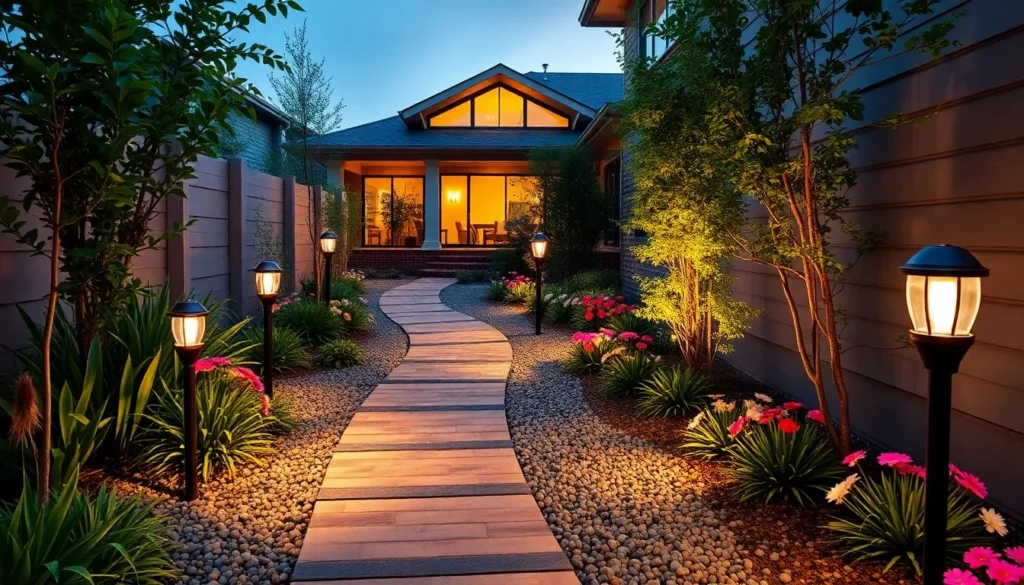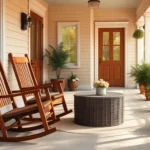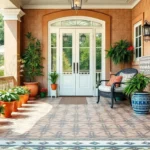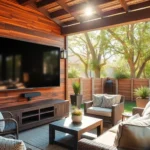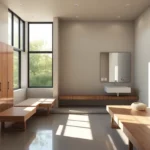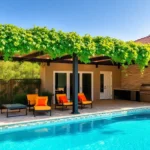We’ve all walked past those narrow side yards and wondered how to transform that awkward space into something functional and beautiful. That often-overlooked strip between your house and fence doesn’t have to remain a forgotten pathway – it’s actually prime real estate for creating an impressive walkway that adds both value and curb appeal to your home.
Side yard walkways present unique design challenges that require creative answers. Unlike front or backyard paths we have more freedom to experiment with materials textures and layouts that reflect our personal style while maximizing the limited space available.
Whether you’re dealing with drainage issues poor lighting or simply want to create a more welcoming entrance to your backyard we’ll explore innovative walkway ideas that turn your side yard from an afterthought into a stunning focal point. From budget-friendly DIY options to luxurious stone installations there’s a perfect solution waiting for every homeowner’s needs and vision.
Create a Classic Brick Walkway for Timeless Appeal
Brick walkways bring enduring elegance to any side yard space while offering exceptional durability that withstands decades of foot traffic. We’ll explore the essential elements that make brick pathways both beautiful and functional for your narrow outdoor corridor.
Choose Traditional Red Brick Patterns
Traditional red brick creates the foundation for walkways that complement virtually any architectural style from colonial to contemporary homes. Clay bricks in classic red tones provide natural color variation that adds visual interest without overwhelming your industry design. We recommend selecting standard-sized bricks measuring 2¼ by 3¾ by 8 inches for consistent spacing and professional appearance.
Running bond patterns offer the simplest installation method where each brick row offsets by half a brick length. Stack bond arrangements create clean horizontal lines by aligning all vertical joints for modern aesthetic appeal. Stretcher bond layouts alternate between lengthwise and widthwise brick placement to generate ever-changing visual rhythm along your side yard pathway.
Incorporate Herringbone or Basket Weave Designs
Herringbone patterns create sophisticated zigzag formations that draw the eye forward while providing excellent structural stability for high-traffic areas. Rectangular bricks positioned at 45-degree angles interlock naturally to distribute weight evenly across the walkway surface. We suggest herringbone designs for side yards that receive regular use since this pattern prevents individual brick movement over time.
Basket weave configurations alternate pairs of parallel bricks with perpendicular pairs to form geometric squares throughout your pathway. Square formations within basket weave patterns create visual breaks that make long narrow walkways appear shorter and more manageable. Parquet-style arrangements combine multiple basket weave squares to develop complex geometric compositions perfect for wider side yard spaces.
| Pattern Type | Installation Difficulty | Visual Impact | Durability Rating |
|---|---|---|---|
| Running Bond | Easy | Moderate | High |
| Herringbone | Moderate | High | Very High |
| Basket Weave | Moderate | High | High |
| Stack Bond | Easy | Low | Moderate |
Add Mortar Joints for Durability
Mortar joints between bricks provide structural integrity that prevents shifting and settling in your side yard walkway over years of use. Portland cement mortar mixed with sand creates strong bonds that resist freeze-thaw cycles and ground movement. We apply mortar joints approximately ½ inch wide to allow proper brick expansion while maintaining pathway stability.
Pointing techniques involve carefully filling joints with mortar then smoothing surfaces for weather-resistant seals. Struck joints feature angled mortar surfaces that shed water effectively to prevent moisture damage during rainy seasons. Flush joints create level surfaces between bricks for easy maintenance while concave joints provide decorative shadows that enhance pattern visibility throughout your walkway design.
Design a Natural Stone Path for Rustic Charm
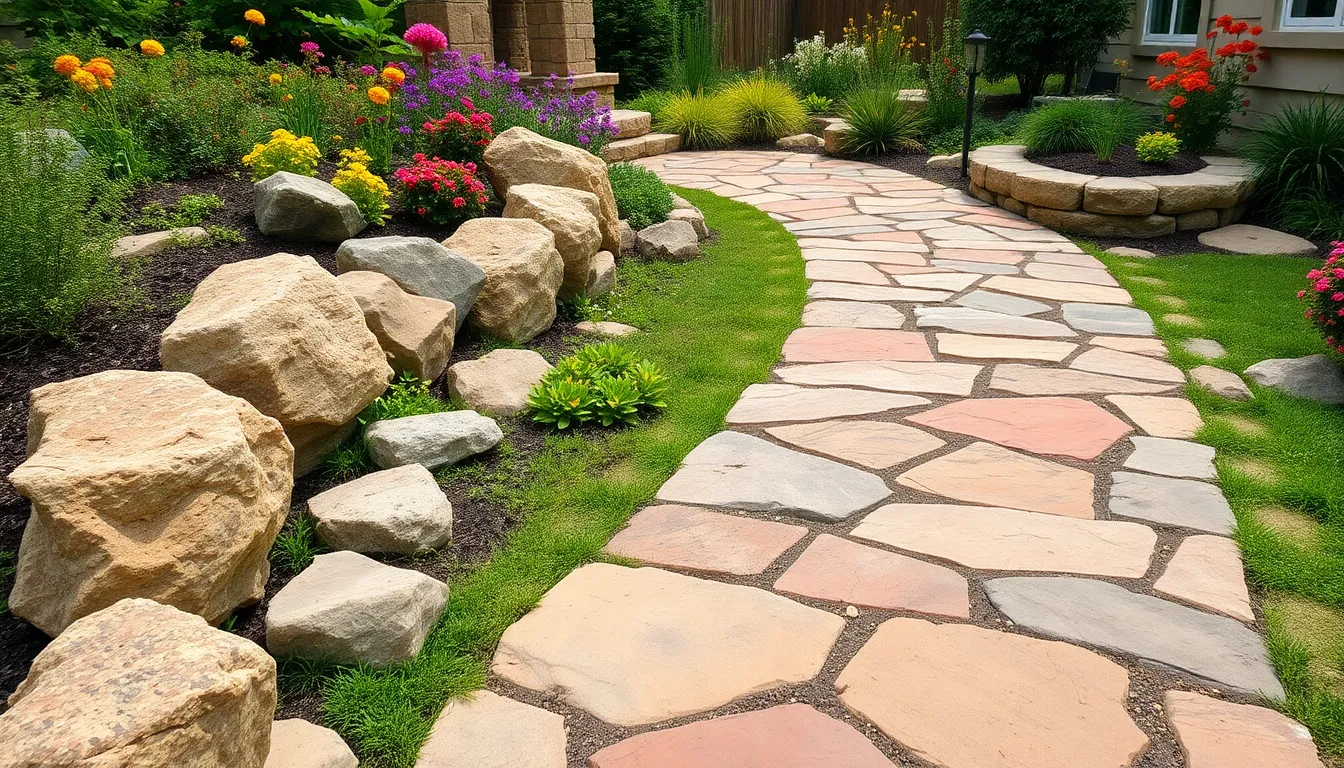
Natural stone paths offer timeless beauty that transforms ordinary side yards into extraordinary outdoor spaces. We’ll explore how different stone materials can create the perfect rustic walkway that complements your home’s natural surroundings.
Select Flagstone for Irregular Beauty
Flagstone creates stunning walkways with its distinctive irregular, flat slabs that fit together like nature’s own puzzle. We love how each flagstone piece brings unique character to your path, making every walkway completely one of a kind. These durable stones provide exceptional longevity while maintaining their natural, rustic appearance year after year.
The uneven shapes and earthy color variations in flagstone make it perfect for casual, countryside inspired landscapes. We recommend leaving spacing between stones to allow grass or ground cover plants to grow through, which softens the overall appearance and enhances the natural appeal. This technique creates a living walkway that feels organic and integrated with your garden environment.
Use Slate for Sleek Modern Lines
Slate delivers sophisticated elegance with its smooth, uniform surface that works beautifully in contemporary industry designs. We appreciate how slate’s thin, flat sheets can be cut into consistent shapes and sizes, creating clean lines and sleek geometric patterns. The dark tones and subtle color variations contribute to a refined walkway aesthetic that pairs perfectly with minimalist garden designs.
This stone material excels in creating sharp edged landscaping features that complement modern architecture. We find slate particularly effective when homeowners want to transition from rustic charm to more structured, contemporary outdoor spaces. The smooth surface provides excellent traction while maintaining its polished appearance through various weather conditions.
Incorporate River Rock Borders
River rocks provide perfect finishing touches as smooth, rounded stones that define walkway edges with natural beauty. We use these versatile materials to create textural contrast along flagstone or slate paths, preventing soil erosion while improving overall aesthetic appeal. The organic shapes and varied sizes of river rocks add visual interest without overwhelming the main pathway design.
These natural borders work exceptionally well in both rustic and modern walkway applications, offering flexibility in design approach. We recommend using river rocks to create gentle transitions between different pathway materials or to establish clear boundaries between walkway and planted areas. Their durability ensures long lasting performance while requiring minimal maintenance throughout the seasons.
Install Concrete Pavers for Budget-Friendly Options
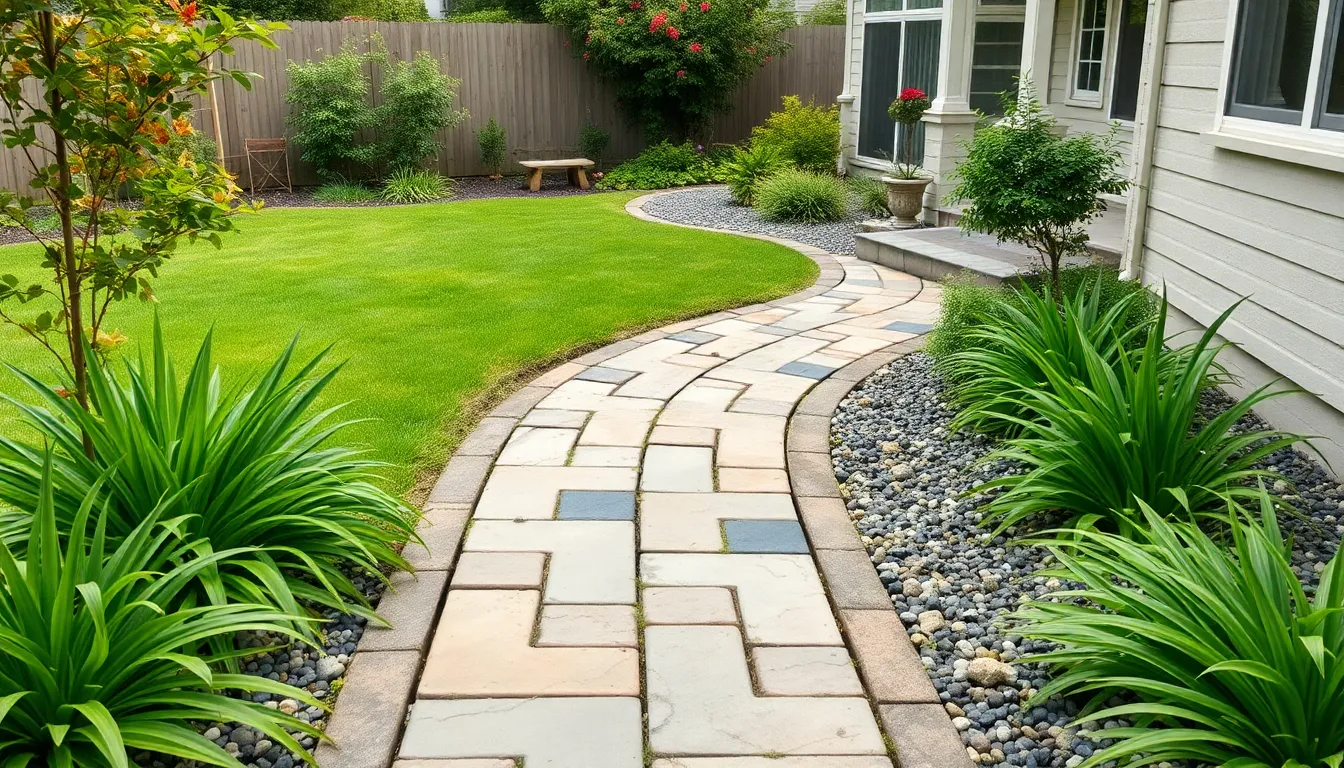
Concrete pavers offer an affordable and versatile solution for creating stunning side yard walkways without very costly. These practical materials come in various shapes and sizes, allowing us to enhance our walkway’s appearance while maintaining cost effectiveness.
Choose Interlocking Designs for Easy Installation
Interlocking concrete pavers simplify our installation process because their design allows them to fit snugly together without requiring mortar. This feature makes DIY projects significantly easier and reduces the time we spend on installation. Their structural integrity ensures uniform appearance while providing the durability needed for walkways that endure regular foot traffic.
We can create professional looking results even as beginners, thanks to the self aligning nature of interlocking systems. The precise fit between pavers eliminates gaps that might otherwise collect debris or become uneven over time. Installation becomes straightforward when we use gravel or mulch as a base, keeping our overall project budget friendly while ensuring proper drainage beneath the walkway surface.
Select Stamped Patterns for Added Texture
Stamped concrete pavers deliver decorative patterns and textures that mimic natural materials like stone, brick, or tile. This option adds visual interest and sophistication to otherwise simple side yard walkways, transforming basic concrete into something that appears far more expensive. Stamping creates custom looks that complement our overall industry design while improving curb appeal throughout the property.
We can choose from many pattern options, each offering different aesthetic benefits for our exact design goals. The textured surface provides better traction than smooth concrete, making our walkway safer during wet conditions. These decorative elements help our side yard walkway blend seamlessly with existing hardscape features while maintaining the budget advantages of concrete materials.
Consider Permeable Pavers for Drainage
Permeable concrete pavers allow water to pass through their surface, reducing runoff and improving drainage throughout our side yard area. This feature becomes particularly beneficial for side yards that collect water or suffer from poor drainage conditions. Permeable options contribute to environmental sustainability by replenishing groundwater and reducing erosion around our walkway edges.
These specialized pavers help us address drainage challenges while maintaining the visual appeal of traditional concrete materials. Water flows through the joints and porous surface, preventing puddles from forming during heavy rainfall. We can combine permeable pavers with other materials like gravel or mulch to create textured designs that balance functionality with aesthetic considerations while staying within our budget parameters.
Build a Gravel Walkway for Low-Maintenance Solutions
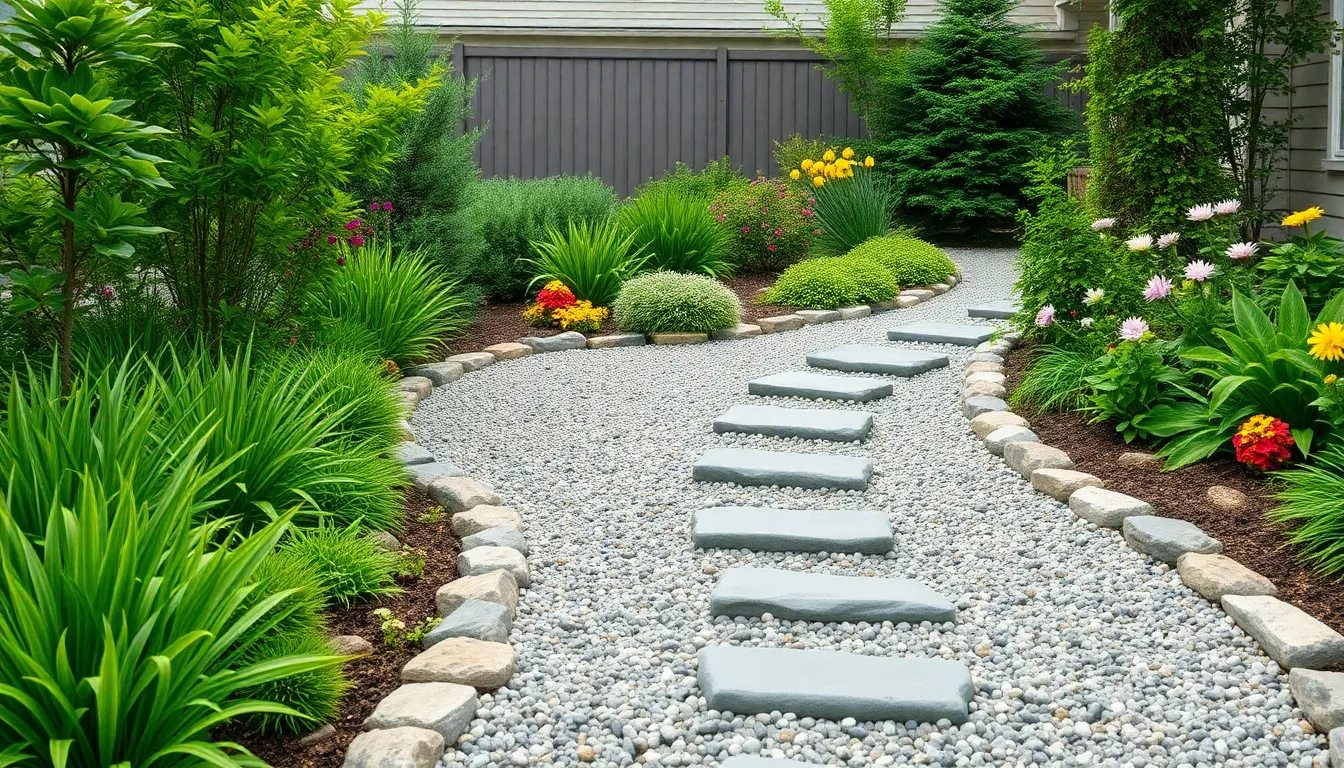
Gravel walkways offer an excellent cost-effective solution that requires minimal upkeep while providing superior drainage for your side yard. We’ll show you how to create a durable pathway that maintains its natural beauty with three essential techniques.
Layer Different Gravel Sizes for Stability
Start your gravel walkway foundation with a base layer of coarse, larger gravel that provides excellent drainage and creates a sturdy foundation. Apply a middle layer of medium-sized gravel to add structural support and prevent the top layer from sinking into the base. Finish with a top layer of fine gravel that creates a smooth, comfortable walking surface.
This layering technique ensures your pathway remains stable over time and prevents gravel from shifting during heavy foot traffic or weather changes. Each layer serves a exact purpose in creating a long-lasting walkway that naturally resists weed growth. The graduated sizing allows water to drain efficiently while maintaining the structural integrity of your side yard pathway.
Add Stepping Stones for Visual Interest
Incorporate stepping stones throughout your gravel pathway to break up the monotonous surface and provide solid footing for comfortable walking. Place stones evenly spaced or create irregular patterns with gravel filling the gaps between each stone for enhanced visual appeal. Choose materials like flagstone or natural boulders that add texture and charm while complementing your existing industry design.
Stepping stones create focal points that guide the eye along your walkway while offering practical benefits during wet weather. They prevent shoes from sinking into gravel and provide stable surfaces for carrying items or walking with mobility aids. The combination of gravel and stones creates a ever-changing pathway that enhances both style and functionality in your side yard space.
Install Proper Edging to Contain Materials
Use edging materials such as metal strips, cedar boards, or natural stone to keep gravel contained within your walkway boundaries. Proper edging prevents gravel from spreading into adjacent lawn areas or garden beds, maintaining clean lines and reducing maintenance requirements. Install edging at ground level or slightly above to create a defined border that separates your pathway from surrounding planting areas.
Quality edging materials make long-term maintenance significantly easier by containing loose gravel and preventing erosion during heavy rains. Choose edging that complements your home’s architectural style and industry design for a cohesive appearance. The defined borders create a professional look that enhances your property’s overall curb appeal while protecting your investment in the walkway installation.
Incorporate Decorative Stepping Stones for Artistic Flair
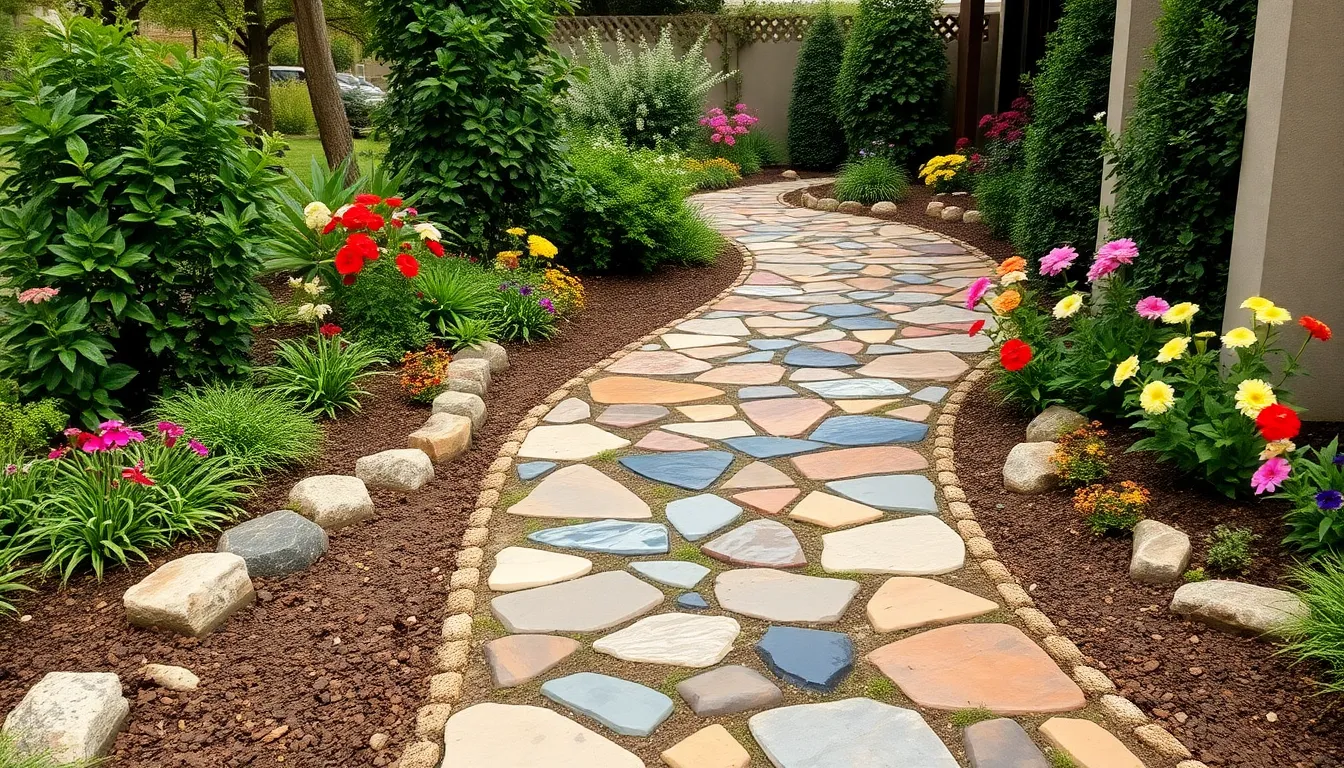
Decorative stepping stones transform ordinary side yard walkways into personalized artistic expressions. These unique elements add visual interest while maintaining functionality, creating focal points that guide visitors through your outdoor space.
Mix Materials Like Mosaic and Natural Stone
Combining mosaic tiles with natural stone creates stunning texture and color contrasts that elevate your walkway’s appeal. Mosaics can fill gaps between larger stones or form decorative borders, while natural stones provide the durability and organic beauty your pathway needs. This material mixing allows for creative patterns that blend rustic elements with refined designs, giving you endless possibilities for customization.
Different textures work together to create depth and visual interest throughout your side yard walkway. Natural stone serves as the foundation, offering long-lasting stability, while mosaic accents add pops of color and intricate detail. We recommend using complementary colors that enhance your home’s exterior palette while creating a cohesive design flow.
Create Custom Designs with Concrete Molds
Custom concrete molds offer a practical solution for crafting personalized walkway stones in various shapes and patterns. These versatile tools allow you to create repeatable artistic motifs that can be stained or painted to match your desired color scheme. Concrete molds prove cost-effective and durable, making them ideal for transforming plain pathways into distinctive decorative features.
Different mold shapes enable you to experiment with geometric patterns, nature-inspired designs, or abstract artistic elements. We suggest creating a consistent theme throughout your walkway by using complementary mold designs that work together harmoniously. Staining options allow you to achieve colors that coordinate with your landscaping and home exterior.
Space Stones for Comfortable Walking
Proper spacing ensures your decorative stepping stones provide comfort and safety for daily use. Stones should be positioned 12 to 18 inches between each center point to accommodate a natural walking stride. This spacing prevents awkward steps while encouraging a leisurely pace that invites enjoyment of your garden surroundings.
Comfortable spacing also considers the size and shape of your decorative stones when planning the layout. Larger stones may require slightly different spacing than smaller ones to maintain walking rhythm. We recommend testing your spacing by walking the path before final installation to ensure optimal comfort for all family members and guests.
Add Lighting Elements to Enhance Safety and Ambiance
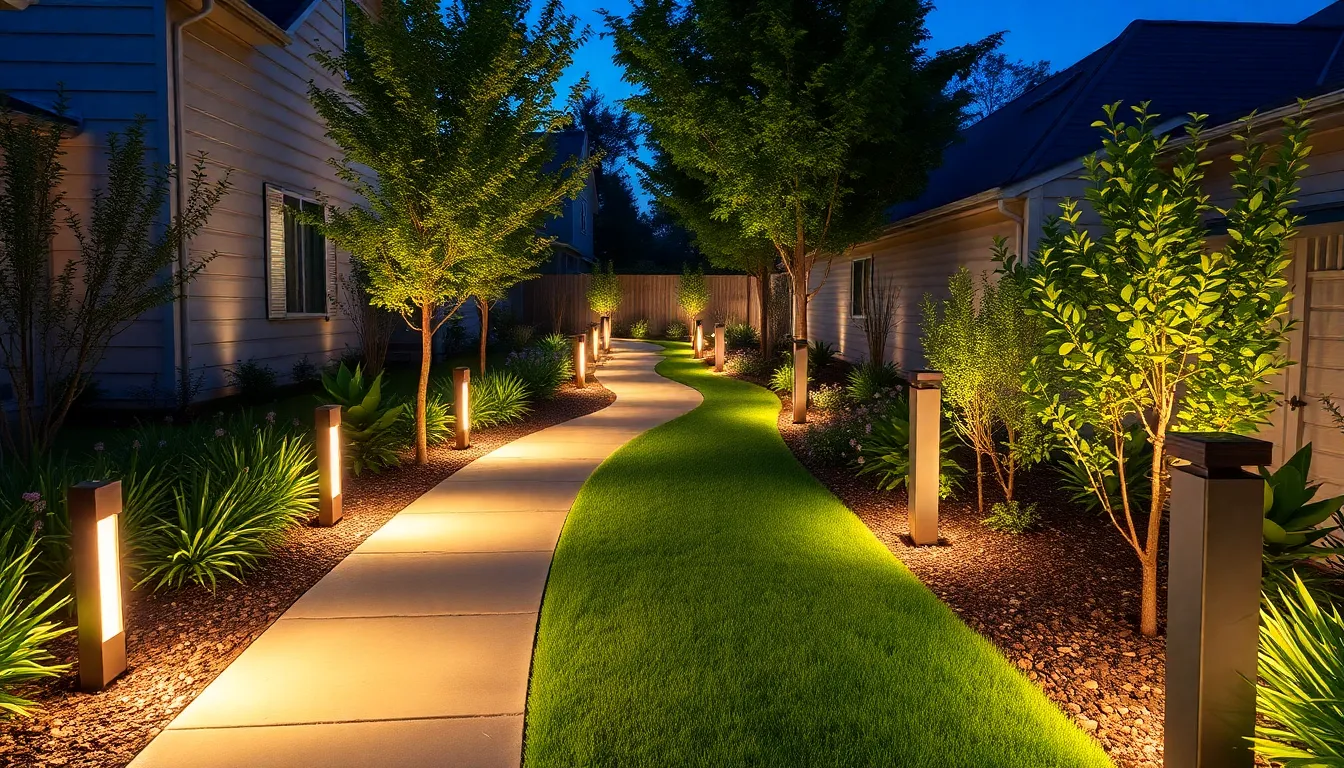
Strategic walkway lighting transforms your side yard into a welcoming space that’s both functional and beautiful after dark. We’ll explore three popular lighting options that enhance safety while creating stunning visual appeal for your outdoor pathway.
Install Solar Path Lights for Eco-Friendly Options
Solar path lights offer an environmentally friendly solution that harnesses sunlight during the day to provide soft evening illumination without increasing energy costs. We recommend staking these lights along the edges of your walkway for subtle, sustainable lighting that requires no electrical wiring. Position solar fixtures approximately 6 feet apart to ensure adequate coverage while maintaining a balanced appearance throughout your pathway.
Choose solar lights with durable materials like stainless steel or weather resistant plastic to withstand outdoor conditions year round. We’ve found that models with higher lumen output provide better visibility while still maintaining that gentle glow perfect for side yard walkways. Battery life varies by manufacturer, but quality solar path lights typically provide 8 to 10 hours of illumination on a full charge.
Use LED Strip Lighting Under Walkway Edges
LED strip lighting creates a modern and sleek effect by casting a gentle glow directly onto your path surface. We install these strips beneath the edges of walkway pavers or along raised borders to achieve discrete lighting with exceptional aesthetic appeal. This method works particularly well for contemporary side yards where clean lines and minimalist design take priority.
Waterproof LED strips ensure longevity in outdoor environments while maintaining consistent light output throughout different weather conditions. We recommend using warm white LEDs (3000K color temperature) to create a welcoming atmosphere that complements natural landscaping elements. Installation requires basic electrical knowledge, but the dramatic visual impact makes this upgrade worth the effort for most homeowners.
Low voltage LED systems operate safely at 12 volts, reducing energy consumption while providing bright, even illumination along your entire walkway. We suggest connecting strips to a timer or smart home system for convenient automated operation.
Place Bollard Lights for Modern Appeal
Bollard lights provide focused illumination through short, post like fixtures installed at strategic intervals along your walkway. We position these stylish lighting answers to enhance walkway visibility while contributing to a chic and clean architectural look that complements contemporary home designs.
Space bollard lights approximately 10 to 12 feet apart to create even lighting distribution without overwhelming your side yard’s proportions. We recommend fixtures with integrated LED technology for energy efficiency and minimal maintenance requirements over traditional bulb based systems.
Consider bollard heights between 24 to 36 inches for optimal light spread and visual balance with surrounding industry features. We often select models with built in shields or louvers to direct light downward onto the walking surface while minimizing glare for nearby windows or neighboring properties.
Include Landscaping Features Along Your Walkway
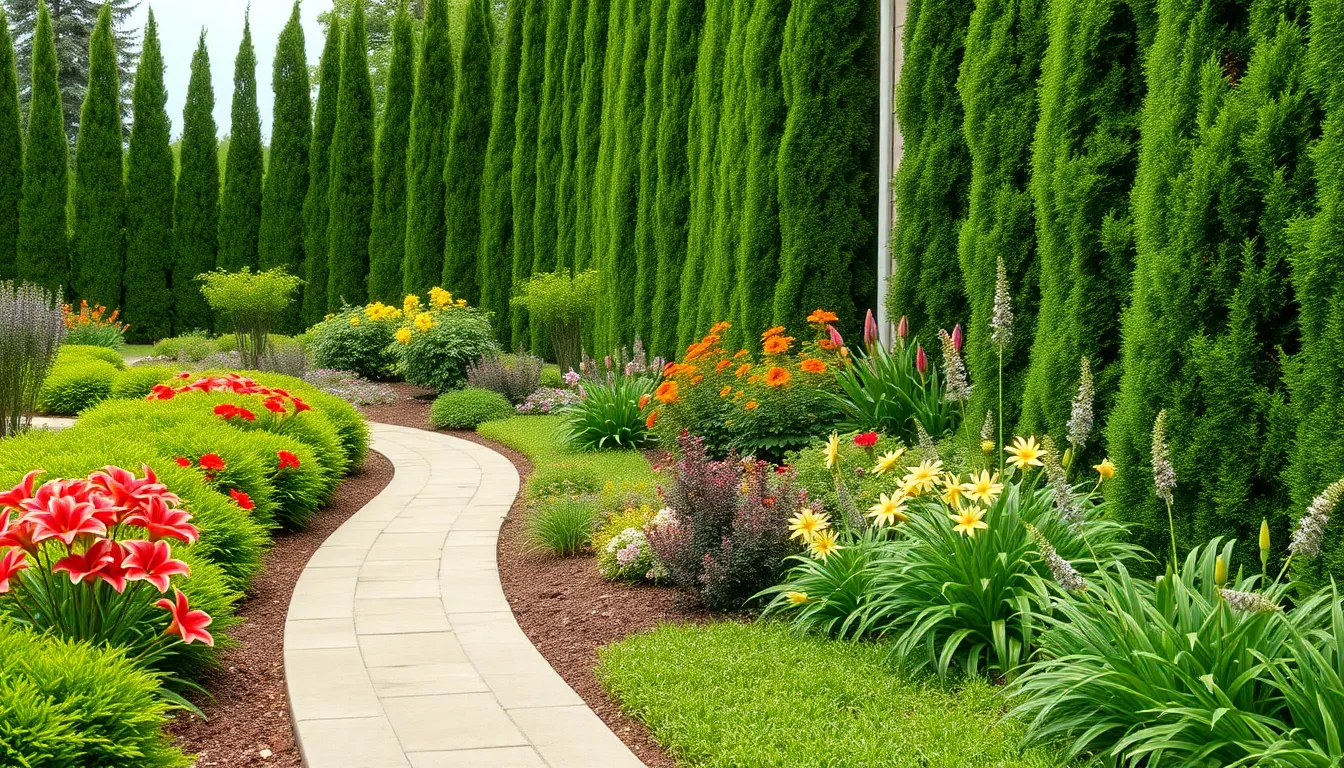
Transforming your side yard walkway into a stunning industry feature requires thoughtful plant selection and strategic design elements. We’ll explore how to create visual interest while maintaining functionality through carefully chosen landscaping features.
Plant Low-Growing Shrubs for Border Definition
Choosing the right shrubs creates clear boundaries that guide foot traffic while adding structure to your walkway design. Podocarpus shrubs offer excellent border definition with their compact growth habit and year-round green foliage. Dwarf varieties work particularly well in narrow side yards since they won’t overwhelm the space or obstruct the walking path.
Installing these low-growing shrubs along your walkway edges prevents visitors from accidentally stepping into planting beds. Arborvitae provides another excellent option for creating natural screens along property boundaries without blocking the walkway itself. These tall, narrow evergreens maintain their shape with minimal pruning while offering privacy from neighboring properties.
Spacing shrubs appropriately ensures they won’t grow together and block pathway access over time. We recommend planting most border shrubs at least 18 to 24 inches from the walkway edge to allow for mature growth.
Add Colorful Flowers for Seasonal Interest
Incorporating flowering plants brings vibrant color and seasonal variety to your walkway throughout the year. Perennials like daylilies, hostas, and astilbe provide reliable blooms that return each season with minimal maintenance requirements. These plants adapt well to various light conditions commonly found in side yards.
Mixing annual flowers with your perennial selections allows you to change color schemes seasonally and experiment with different combinations. Begonias, impatiens, and caladiums thrive in shadier side yard conditions while providing continuous color from spring through fall.
Adding ornamental grasses creates textural contrast against flowering plants while maintaining visual interest during winter months. Fountain grass and Japanese forest grass offer movement and sound when breezes pass through their delicate blades.
Planning your flower selections based on your side yard’s exact sun exposure ensures healthy growth and abundant blooms. We suggest observing light patterns throughout the day before selecting plants to guarantee optimal performance.
Incorporate Ground Cover to Soften Hard Edges
Ground cover plants create smooth transitions between your walkway and surrounding industry while reducing maintenance needs. Creeping thyme releases a pleasant fragrance when stepped on and produces small purple flowers in late spring. This hardy ground cover tolerates foot traffic and spreads naturally to fill gaps along pathway edges.
Moss provides an excellent low-maintenance option for shaded side yard areas where grass struggles to grow. Japanese moss and sheet moss create lush green carpets that soften the appearance of stone or brick walkways.
Installing low-growing sedum varieties offers drought-tolerant ground cover that requires minimal watering once established. These succulent plants produce colorful flowers and interesting foliage textures while suppressing weed growth along walkway borders.
Ground cover selections help prevent soil erosion on sloped side yards while reducing the need for frequent weeding and maintenance. We recommend choosing varieties that match your climate zone and soil conditions for the best long-term results.
Consider Wooden Walkways for Natural Integration
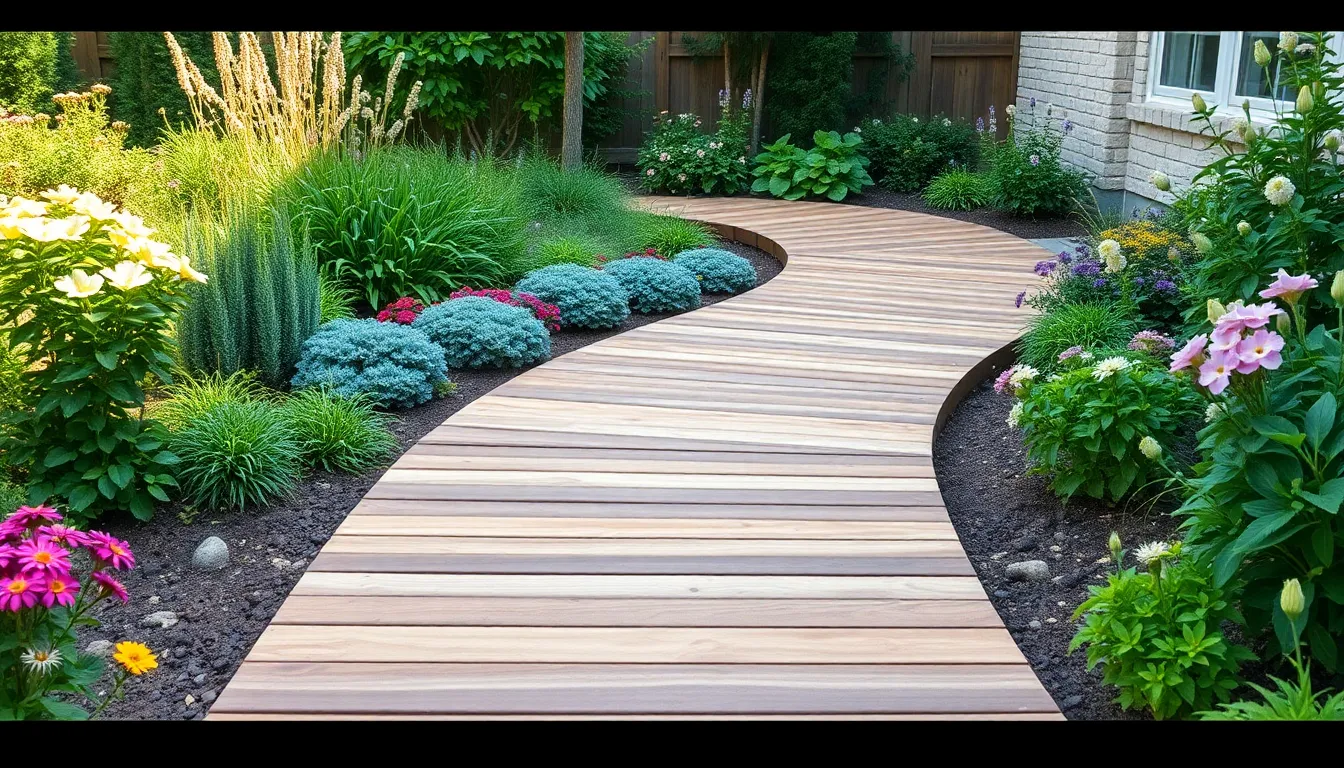
Wooden walkways create a seamless connection between your home and garden, offering warmth and organic beauty that complements natural landscaping elements. We’ll explore how to design durable, attractive wooden paths that enhance your side yard’s aesthetic appeal.
Use Cedar or Teak for Weather Resistance
Cedar delivers exceptional durability for outdoor walkways while naturally repelling insects and resisting rot. This North American favorite maintains its structural integrity through harsh weather conditions without requiring frequent treatments or replacements.
Teak provides superior strength and weather resistance, making it an ideal choice for side yard walkways exposed to moisture and temperature fluctuations. We recommend teak for its ability to withstand cracking and warping over time, ensuring your investment remains beautiful for decades.
Both materials offer low maintenance requirements compared to other wood options. Cedar develops an attractive silver gray patina naturally, while teak can be treated with oil to maintain its rich golden color or left to weather to an elegant silver tone.
| Wood Type | Weather Resistance | Maintenance Level | Estimated Lifespan |
|---|---|---|---|
| Cedar | High | Low | 15-20 years |
| Teak | Very High | Very Low | 25-30 years |
Create Boardwalk-Style Planking
Boardwalk style planking adds distinctive texture and visual interest to narrow side yard spaces. Install wooden planks horizontally with 1/4 inch spacing between boards to allow proper water drainage and prevent moisture buildup.
This installation method works particularly well in coastal or rustic themed landscapes where the maritime aesthetic enhances the overall design. We suggest using planks that are 6 to 8 inches wide for optimal visual impact and structural stability.
Consider alternating plank lengths to create a more ever-changing appearance that breaks up monotonous lines. Running planks longitudinally along the walkway’s length can make narrow side yards appear wider and more spacious.
Add Non-Slip Surfaces for Safety
Non-slip coatings provide essential safety features for wooden walkways, especially in shaded side yards where moisture creates slippery conditions. Apply specialized deck coatings that contain anti-slip additives to maintain traction while preserving the wood’s natural appearance.
Anti-slip strips integrate seamlessly into wooden planks during installation, offering permanent traction without affecting the walkway’s aesthetic appeal. These strips typically come in clear or wood toned colors that blend with your chosen lumber.
Textured wood finishes increase natural traction through rough sawn surfaces that provide grip without additional treatments. We recommend discussing finish options with your supplier to find the best balance between safety and visual appeal for your exact climate conditions.
Strategic placement of these safety features ensures secure footing during all weather conditions while maintaining the walkway’s natural integration with your industry design.
Design Curved Pathways to Maximize Small Spaces
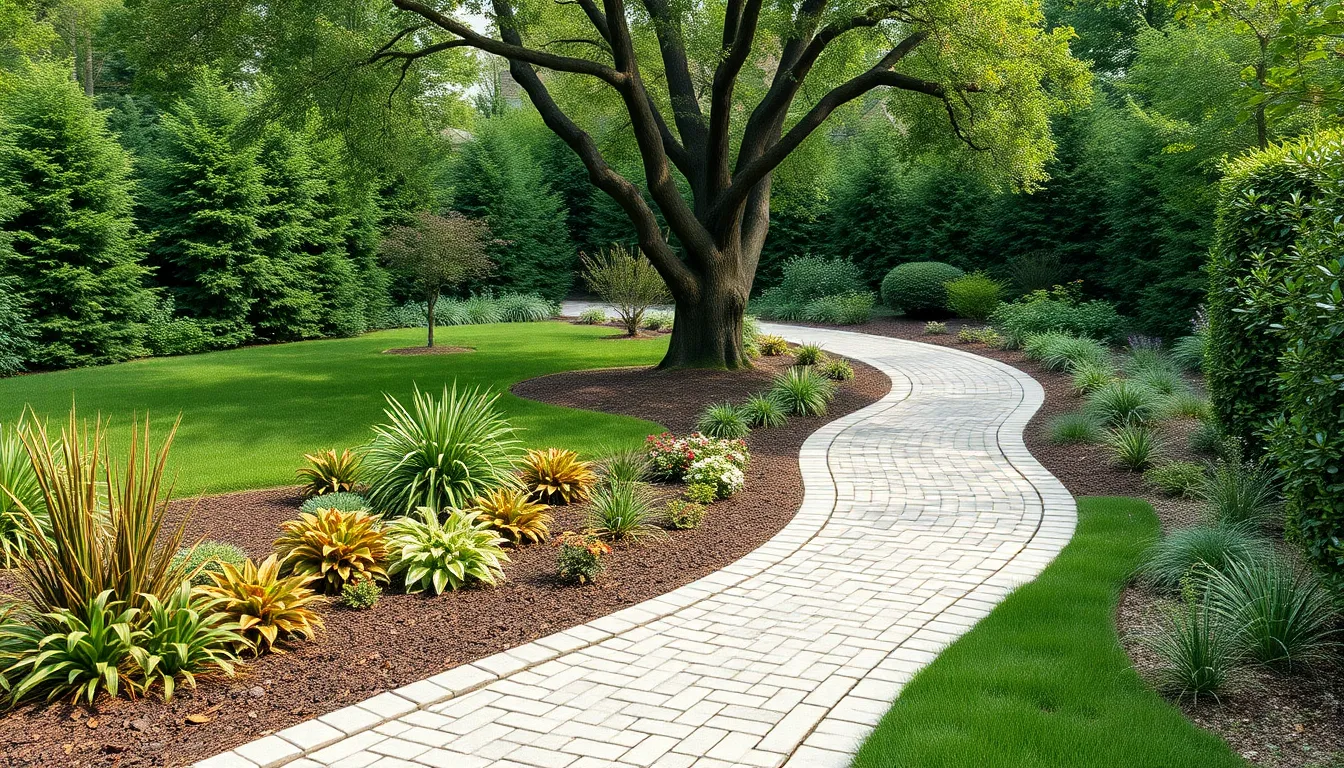
Curved pathways offer an ingenious solution for transforming cramped side yards into spacious-feeling outdoor corridors. These gentle curves create visual depth and make narrow spaces appear larger than their actual dimensions.
Follow Natural Industry Contours
Aligning your walkway with the natural slope and shape of your side yard creates a harmonious flow that feels organic rather than forced. Working with existing terrain minimizes disruption to established plants and reduces construction complexity while lowering overall costs. This approach allows the path to integrate seamlessly with garden beds, mature trees, or natural berms already present in your industry.
Respecting the natural grade prevents water pooling issues and maintains proper drainage throughout the walkway. Following these contours also preserves the root systems of existing vegetation, ensuring your established plants continue to thrive alongside your new pathway.
Create Gentle S-Curves for Visual Flow
Designing soft S-curves guides visitors’ eyes along the entire length of your side yard, creating an inviting journey rather than a simple transit zone. These flowing lines break up the linear nature of narrow spaces and add visual interest that makes the area feel more spacious and welcoming.
Planning curves with a gentle radius prevents sharp turns that can feel awkward or interrupt the natural walking rhythm. Strategic placement of these curves can also create intimate spaces or focal points along the journey, transforming a utilitarian pathway into an captivating industry feature.
Incorporating subtle directional changes helps visitors slow down and appreciate surrounding plantings or decorative elements you’ve incorporated into the design.
Use Flexible Materials Like Brick or Small Pavers
Materials that accommodate curves easily include brick, small pavers, decomposed granite, and river rock, all of which allow for smooth transitions around bends. These flexible options enable the creation of flowing paths that follow your desired curve without requiring extensive cutting or custom fitting.
Brick pavers work exceptionally well for curved designs because their small size allows for natural fan patterns that maintain consistent joint spacing throughout turns. Small pavers offer similar benefits while providing more color and texture options to complement your home’s architectural style.
Budget-friendly alternatives like gravel and mulch also enhance visual appeal while remaining easy to install and maintain along curved pathways. These materials naturally conform to any shape you create and provide excellent drainage properties essential for side yard applications.
Combine Multiple Materials for Unique Side Yard Walkway Ideas
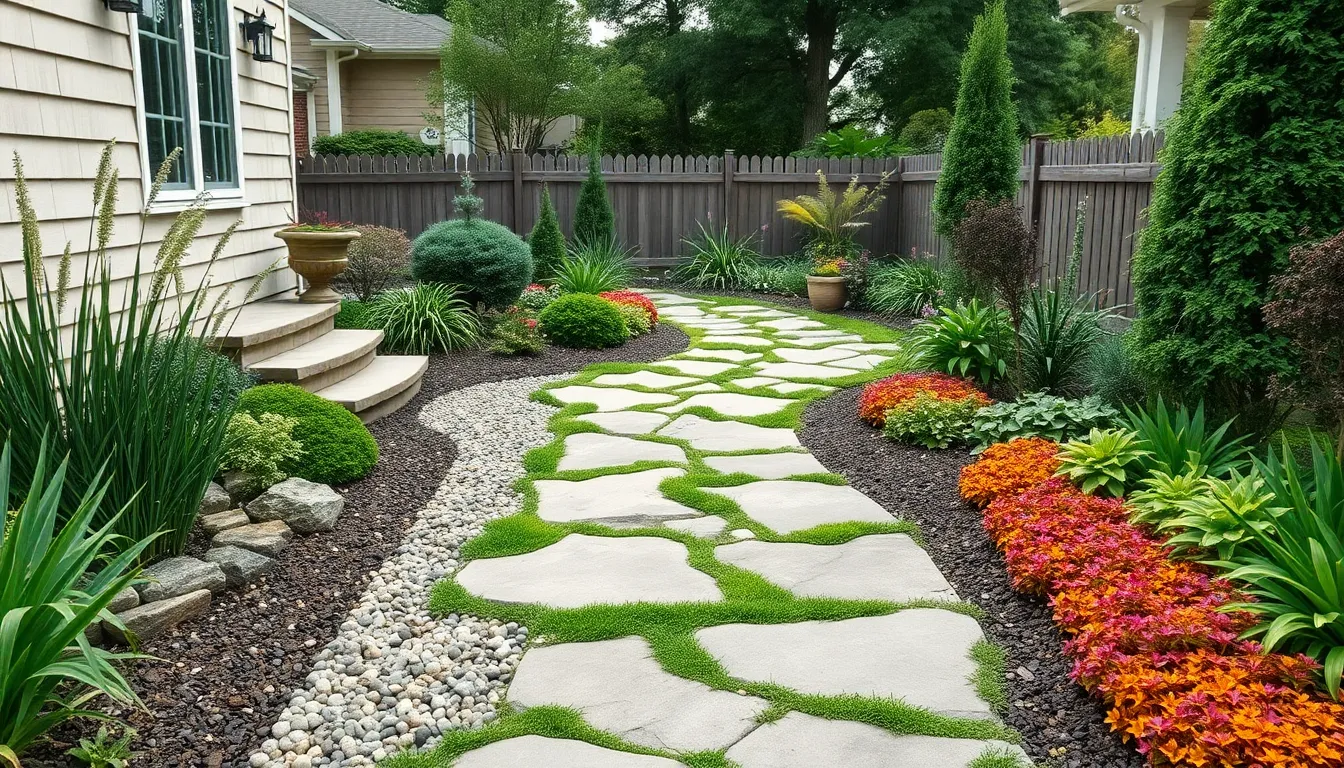
Creative material combinations transform ordinary walkways into distinctive industry features that showcase your personal style. We’ll explore proven techniques that blend different textures and elements for maximum visual impact.
Mix Stone and Gravel for Textural Contrast
Stone and gravel combinations create visually striking walkways with exceptional drainage capabilities. Large stepping stones or flagstones positioned within gravel beds form durable, permeable paths that handle water runoff effectively. Gravel fills the spaces between stones, softening harsh edges while adding rustic charm to your side yard design.
Budget-conscious homeowners appreciate this low maintenance approach that delivers both functionality and aesthetics. Narrower side yards benefit particularly from this style since the textural contrast makes spaces appear larger. Maintenance requirements stay minimal because gravel naturally settles around stones, creating a stable walking surface that withstands weather changes.
Alternate Concrete and Planted Sections
Concrete slabs alternated with planted areas break up hardscape monotony while integrating greenery directly into your walkway design. Ground cover plants or low-growing grasses thrive in these planted sections, making paths feel connected to surrounding garden spaces. Irregular concrete shapes combined with soft plantings prevent tunnel-like feelings that narrow side yards often create.
Visual interest increases dramatically when you incorporate gentle curves instead of straight concrete lines. Spaciousness improves as planted sections provide breathing room between solid walking surfaces. We recommend selecting drought-tolerant ground covers that won’t require frequent watering or extensive maintenance throughout growing seasons.
Blend Wood and Stone Elements
Wood and stone combinations deliver warmth alongside durability for side yard walkways that feel both organic and sophisticated. Wooden planks or timber sleepers pair beautifully with stone pavers or gravel, creating natural transitions that complement rustic or contemporary garden styles. Cedar and teak provide weather resistance while maintaining their attractive appearance over time.
Texture variety emerges when you contrast wood’s softness against stone’s solid presence, resulting in walkways that feel inviting rather than stark. Installation becomes more straightforward since wood elements can bridge irregular stone spacing while providing stable footing. Naturalistic garden designs particularly benefit from these material blends that echo forest floor patterns and organic woodland paths.
Conclusion
Your side yard walkway doesn’t have to be an afterthought. With the right combination of materials lighting and landscaping we’ve shown you how these narrow spaces can become stunning focal points that enhance your home’s value and curb appeal.
Whether you choose classic brick elegant natural stone or budget-friendly concrete pavers the key lies in thoughtful planning and creative execution. Remember that combining materials often produces the most striking results while proper drainage and safety features ensure long-lasting beauty.
We encourage you to experiment with these ideas and adapt them to your exact space and style preferences. Your side yard walkway can truly become a beautiful transition that connects your outdoor spaces while reflecting your personal taste and vision.
Frequently Asked Questions
What are the benefits of creating a walkway in my side yard?
Side yard walkways significantly enhance your home’s curb appeal and property value while transforming underutilized narrow spaces into functional pathways. They provide safe passage, create visual interest, and offer unique opportunities for creative design experimentation with various materials and layouts.
Which walkway material is best for beginners on a budget?
Concrete pavers are ideal for budget-conscious beginners due to their affordability and easy installation. Interlocking designs simplify the DIY process, while stamped concrete pavers offer decorative patterns that mimic expensive natural materials without the high cost.
How do I choose between brick and natural stone for my walkway?
Choose brick for timeless appeal, exceptional durability, and various pattern options like herringbone or basket weave. Select natural stone like flagstone for rustic charm and organic beauty, or slate for sleek, modern elegance. Consider your home’s style and maintenance preferences.
What’s the advantage of using gravel for side yard walkways?
Gravel walkways offer superior drainage, low maintenance, and cost-effectiveness. They’re easy to install and repair, making them perfect for DIY projects. Proper layering techniques and edging ensure stability while stepping stones can add visual interest and functionality.
How can I improve drainage in my walkway design?
Use permeable pavers that allow water to pass through, improving environmental sustainability. Gravel walkways naturally provide excellent drainage. For other materials, ensure proper grading and consider incorporating gaps between stones or pavers for water infiltration.
What lighting options work best for side yard walkways?
Solar path lights are eco-friendly and require no wiring, providing soft illumination. LED strip lighting offers a modern aesthetic when installed under walkway edges. Bollard lights provide focused illumination with stylish design, enhancing both safety and contemporary appeal.
How do I incorporate plants into my walkway design?
Plant low-growing shrubs like Podocarpus to define borders, add colorful perennials for seasonal interest, and use ornamental grasses for texture. Ground cover plants like creeping thyme can grow between stones, softening hard edges while reducing maintenance needs.
Can I create curves in a narrow side yard walkway?
Yes, gentle curves create visual depth and make narrow spaces feel larger. Use flexible materials like brick, small pavers, or gravel to accommodate curves easily. Align walkways with natural yard contours to minimize disruption and preserve existing vegetation.
What’s the best way to combine different walkway materials?
Mix stone and gravel for striking visual contrast with excellent drainage. Alternate concrete slabs with planted sections to integrate greenery, or blend wood and stone elements for warmth and organic appeal. Ensure materials complement each other and your home’s style.
How do I maintain different types of walkway materials?
Gravel requires occasional raking and replenishment. Brick and stone need periodic cleaning and repointing of mortar joints. Concrete pavers may need occasional pressure washing. Wooden walkways require regular sealing, while proper edging reduces maintenance for all materials.

